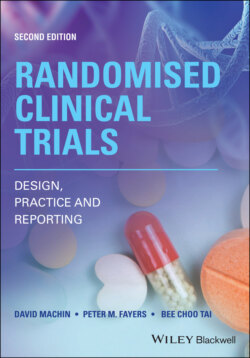Читать книгу Randomised Clinical Trials - David Machin - Страница 39
1.7 How do trials arise?
ОглавлениеAlthough the focus of this book is on comparative, or Phase III, trials to establish the relative efficacy of the interventions under test, it should be recognised that these may be preceded by an often extensive research programme starting with the laboratory bench, moving to animal studies and then to early and later stage studies in man. Also once the Phase III stage itself is complete, there may be further studies initiated. Figure 1.5, taken from Campbell, Fitzpatrick, Haines, et al. (2000), succinctly summarises the pathway of the whole trial process.
Figure 1.5 Sequential phases of developing randomised controlled trials of complex interventions.
Source: Campbell, Fitzpatrick, Haines, et al., (2000).
The steps range from studies to determine the pharmacokinetic profile of a drug in healthy volunteers (Preclinical) to establishing the appropriate dosage for use in man (Phase I), then the establishment of indications of activity (Phase II). However, some of these steps may be taken in parallel and even simultaneously in the same subjects.
These early studies are not usually randomised. However, studies conducted by Krishna, Anderson, Bergman, et al. (2007) on the effect of the cholesteryl ester transfer protein inhibitor, anacetrapib, on lipoproteins in patients with dyslipidaemia are described by them as ‘randomized’ and ‘phase I’. Randomised they undoubtedly are but their use of the Phase I nomenclature does not have an exact parallel in Figure 1.4. This highlights a difficulty when attempting to categorise trials using such a simple system. One may imagine that there will be clear stages in the development of a bioabsorbable coronary stent. These too will not exactly parallel those of drug development although they may well involve laboratory and animal studies. The single‐arm trial of Erbel, Di Mario, Bartunek, et al. (2007) may be considered as close to the Phase II type or a feasibility study of Chapter 19.
There are also parallels (although modifications will be necessary) for new approaches to, for example, surgical, radiotherapy or physiotherapy techniques, and combinations of different procedures. They also extend beyond merely therapeutic trials to planning, for example, trials comparing alternative forms of contraception in women and those evaluating alternative health promotion interventions. However, in some instances, such as in trials comparing educational packages, they may start at the full Phase III stage without involving the earlier phases.
Alternatively, comparative trials may evolve from questions arising in clinical practice and not from a specific development process. Thus, one may wish to compare different surgical timings, at 6 months or at 1 year of age, for reconstructive surgery in infants with cleft palate as is proposed in the trial conducted by Yeow, Young, Chen, et al. (2019).
Whatever the pathway, the eventual randomised comparative trial to be conducted is clearly a major event as only when this has been conducted will there be reliable (although not necessarily convincing) evidence of the efficacy of the intervention concerned. In certain situations, often for regulatory purposes, a Phase III trial may be followed by a confirmatory trial asking essentially the same question. In addition, following regulatory approval of a product, so‐called Phase IV or postmarketing trials may be initiated with the aim to gain broader experience with using the new product.
